The movie Under the Tuscan Sun made Tuscany look irresistibly delicious, and that was a true portrayal. It really is a perfect place, with invigorating weather and gorgeous landscapes that make you feel as if you’ve been swept into a Renaissance painting. And the food! That alone would make it worth the trip.
Tuscany has a lot going for it. As the home of Florence, it brings a lot of people in to see the birthplace of the Renaissance. And they are well-situated to explore Tuscany further. The rise of interest in cuisine over the last couple of decades has fueled interest in Tuscany because Tuscan cuisine is one of the world’s culinary treasures.

With all this in mind, I signed up for a tour that was designed to show a curated selection of some of the finer points of Tuscany. It was a beginning of an exploration that could go on indefinitely, without running out of things to experience. Tuscany is of one of Italy’s 20 administrative regions. It’s roughly the size of New Hampshire, and within that area, there’s tremendous richness to experience, the charming Tuscan hill towns of Siena, San Gimignano and Cortona; many fine vineyards and the near-vertical seaside landscape of the towns of Cinque Terre.
I booked a small group tour designed to be active and immersive, focusing entirely on Tuscany. My tour began in Florence, the city that gave birth to the Renaissance. I landed at the Amerigo Vespucci Airport in the early afternoon, was met at the airport and taken to my hotel near the Arno River at the heart of the old city.
The way my flights had worked out, I only had time to drop off my things in my room and then to head out on a walking tour. Within moments of reaching the hotel, I was out on the sunny, lively streets of Florence. The Renaissance city was dressed up in its most radiant glory. The weather was like heaven.
I was walking through the narrow, winding streets among the students, tourists, apartment dwellers, shop owners, restaurant workers, and the lady polizia. Italy is the one place I have been where the police look like fashion models in neatly tailored uniforms. Italians know how to wear clothes. It’s a mark of their culture. Even the older men look trim and stylish.
Walking around sightseeing was a perfect way to adjust to the new time zone, which was several hours later than at home. Florence was humming at a high pitch of energy. It was a thrilling introduction to the city.
Touring in Florence was a kaleidoscope of rich impressions. We walked around in the Piazza della Signoria, where Michelangelo’s David stood for nearly 400 years until someone took a hammer to one of the toes in 1873, marking the end of the age of sanity. There’s a copy there now. It’s stunning, though it lacks the glowing magic of the original, which can now be seen safely sequestered at Galleria dell’Accademia about a mile away.
Near the David replica in Piazza della Signoria is the Baccio Bandinelli sculpture of Hercules and Cacus. Not far beyond that is Benvenuto Cellini’s arresting statue of Perseus holding the head of Medusa, and Giambologna’s The Rape of the Sabine Women. It’s not exactly a G-rated collection, but there it is, in Florence’s busiest plaza, for all to see. The grand plaza is lined with restaurants and boutiques and sidewalk cafes where the life of Florence plays out deliciously before you.
We walked over the ancient Ponte Vecchio Bridge, taking in the breathtaking Florentine landscape along the banks of the Arno River, with the red clay tile roofs on the buildings along the river’s edge. It was easy to see why the great artists were so inspired there.
That evening was the welcome dinner. I had some intriguing talks with people I would be traveling with for the next several days. They were all congenial folks, people with interesting backgrounds, bringing their own worlds aboard to share their perspectives with the others as we progress through the different experiences in the itinerary.
The restaurant was amazing, with booths next to windows overlooking the Arno, colorful paintings, of course, and a lively clientele. The building directly across the river reflected in the green waters with just a slight ripple.
Practically every major tourist landmark in Florence was within comfortable walking distance of my hotel. A few blocks away was Piazza Della Repubblica, a vast square crowned by a mighty triumphal arch, lined with restaurants, vendors, performers and a carousel. Built on the site of the Roman forum, the center of the Roman city, the square’s construction marked the unification of Italy in the late 19th century during the brief time when Florence was the capital.
Several small blocks farther, Piazza Del Duomo surrounds the enormous Basilica di Santa Maria del Fiore, with its dizzyingly intricate designs of red, green and white marble, and its tall tower and orange dome.
Florence, Firenze, was all consuming. The place is so much larger than life one could be sucked into it and never emerge. It was the center of the Renaissance and remains the center of its own universe. When you are in Florence it is hard to imagine anywhere else exists.
But once we left Florence behind, we saw that indeed there is a world beyond, and it began to come into view as Florence receded on our horizon. We traveled across the rich Tuscan landscape, with its gentle hills adorned with olive trees and cypresses.
We spent some time in Lucca, a historically rich, walled city with traces of human settlement dating to the third century BC. There was much great architecture to see there, such as the Lucca Cathedral, a monumental structure in the historic old town in the Piazza San Martino. We listened to a vocal performance of arias in a church and rode bikes around its ancient city walls.
By the time we finished our time in Tuscany we had hiked in Fiesole near the sandstone quarries where Leonardo Da Vinci conducted his flying experiments; learned how to make our own pasta; listened to a lecture on Michelangelo by an art history professor at Syracuse University’s Florence campus; taken a private tour through the restricted Vasari corridor of the Uffizi Gallery; taken a lesson in conversational Italian; tasted a variety of wines, and enjoyed a plethora of other fascinating experiences.
Our exploration of Tuscany lasted about a week. One might as easily stay three months, or three years, or 30 years, but one must eventually move on. By the end of the week, I was not much closer to being an expert on wines, cheeses and olive oil. Alas. But I had learned some things that will enrich my life going forward. The experience catalyzed a significant shift in my attitudes and understanding. Viva Italia!
Your humble reporter,
Colin Treadwell

